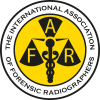Learn more about the IAFR
The International Association of Forensic Radiographers (IAFR) is an association of professionals involved in, or with an interest in, the provision of medical imaging services in support of forensic investigations
About Us
The Trauma Imaging Group Forensic Radiography Committee (TIGFR) was founded in the United Kingdom in 1998. In 2004 TIGFR combined with the UK Northern Region Radiography Response Team and the UK Military Radiographers Forensic Team to establish the Association of Forensic Radiographers (AFR). AFR was formally constituted in 2005. In recognition of an increasingly international membership, the Association formally changed its name to the International Association of Forensic Radiographers (IAFR) in 2008.

Recognised Lead Body
The IAFR is the recognised by the ISRRT and SCoR to be the lead body in promoting forensic radiography.
Organising DVI Response
The IAFR helps coordinating DVI radiography response. Currently we have a designated DVI team in UK.
Education & Research
The IAFR promotes the best practices in forensic radiography by providing education and organising research.
IAFR Committee
The Association has a committee, elected from the membership, that works within its constitution.

Amy is the Post-Mortem CT Lead and advanced practitioner in forensic and post-mortem radiography at LTHTR. She has extensive post-mortem and forensic experience in adult PM cases in plain-film, CT and PM angiography and in live SPA cases and PM paediatric cases including SPA, SUDI and forensics. Additionally, she has deployment experience in DVI.
Amy-Lee Brookes
BSc, MSc, CertFHID

Courtney is a supervising radiographer from Perth, Western Australia, where she trained and currently lives. Following a love of travel, she has also lived and worked in the Northern Territory and the United Kingdom, where she gained experience in forensic imaging, focusing on her main interests in Post Mortem CT and Disaster Victim Identification.
Courtney Steels
BSc (Hons), Prof.Cert.
Originally from Malaysia, Faye now works in Canberra where she is also a sessional academic with the University of Canberra. With a strong interest in forensic science and post-mortem angiography, she has presented at a number of conferences and forums and is keen to complete her Masters of Forensic Radiography.
Faye Jong
BSc
Paula Sylvester
Charlotte (Charlie) has a background as a trained biological anthropologist as well as a diagnostic radiographer. Currently she works as an assistant professor in forensic imaging at the University of Warwick, acquiring and analysing postmortem micro-CT images for trauma analysis of both adult and paediatric cases in assault and NAI cases.
Charlotte Primeau
BSc (Hons), MSc, MSc, PGCert, PhD, FRAI (Cert FA-III)
Paul Hunter
Louise is a senior lecturer at University of Liverpool, as well as an advanced practitioner in plain film MSK reporting. She was awarded her PhD in June 2024. She has been interested and involved in forensic radiography for many years with a particular interest in non-accidental injury and DVI. Professionally she loves sharing her passion for reporting and forensic work. Outside of this she loves Harry Potter, Christmas and over catering.
Louise Burton
BSc (Hons), PgC, PgC, PhD
Claire is a Consultant Radiographer in forensic imaging in Leicester, UK where she runs the forensic imaging services. She has been involved in forensic imaging and research for over 20 years during which she has helped develop coronary PMCT angiography and the use of PMCT in DVI.
Claire Robinson MBE
BSc, MSc, PhD

The Constitution
The International Association of Forensic Radiographers (IAFR) is an association of professionals involved in, or with an interest in, the provision of medical imaging services in support of forensic investigations. The Association has a committee, elected from the membership, and works within its constitution.
With effect from 22nd September 2012 IAFR has entered into a formal affiliation with the International Society of Forensic Radiology and Imaging (ISFRI).
Formal Recognition
IAFR has been formally recognised by the International Society of Radiographers and Radiologic Technologists (ISRRT) and the UK Society and College of Radiographers (SCoR) as the lead body in the following areas:
Promoting awareness of forensic radiography and related issues
Provision and facilitation of training and education in the forensic field
Inter-professional and multi-organisational liaison and communication
Development and review of guidelines for evidence-based practice in forensic radiography
Provision of advice and resources for individuals and organisations which have a need for professional expertise
Provision of health and safety advice in the planning of temporary mortuaries, including risk assessments with particular regard to radiation protection, COSHH and manual handling issues
As the contact point for initiation of a Radiography Response Team in the event of a Mass Fatality Incident, including provision of diagnostic imaging equipment for immediate deployment to an incident
Who Are We?
The majority of IAFR members have clinical backgrounds and therefore specialise in the imaging of human subjects. However, X-rays can also be used for the imaging of a wide range of artefacts – from documents, paintings and antiques to vehicles and suspect packages in forensic investigation.
IAFR members have been involved in incidents on both a national and international level. In the United Kingdom, these include investigation into the London bombings, the Selby rail crash and Lockerbie air disaster. International deployments have included investigations in Bosnia, Kosovo, Croatia, Republic of Ireland, Sierra Leone, Sri Lanka and India.
IAFR provides a consultancy service to the UK Home Office, the UK Ministry of Defence, UK police forces, UK Department of Health, the UK National Health Service, United Nations and other organisations on forensic imaging of the living and deceased.
